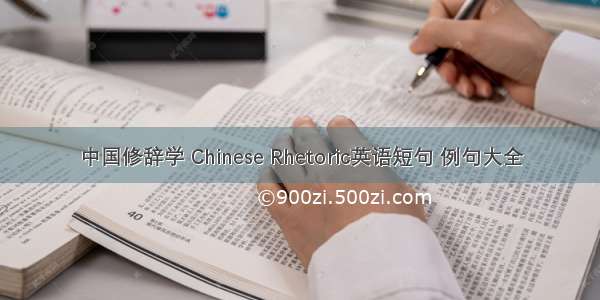
汉语修辞史,Chinese rhetoric history
1)Chinese rhetoric history汉语修辞史
1.With reforming and the opening to the outside world, the study of Chinese rhetoric(修辞学) has gained great achievement while the study ofChinese rhetoric history is nearly a blank space, so it seems unbalanced.改革开放以来,汉语修辞学研究在各方面取得了很大成就,但汉语修辞史研究却几乎是空白,从而显得很不平衡。
2.The article discusses Qian Zhongshu\"s(钱钟书) researching onChinese rhetoric history from the perspective of methodology.本文从方法论角度探讨钱钟书的汉语修辞史研究,文章分四个部分:修辞史研究与修辞学史研究相结合;专书研究与专题研究相结合;内部研究与外部研究相结合;现象描写与原因解释相结合。
英文短句/例句
1.Rhetoricization:A Theoretic Topic in the Studies of the History of Chinese Rhetoric修辞化:汉语修辞史研究的理论探索话题
2.On Methodology in Qian Zhongshu"s(钱钟书) Researching on Chinese Rhetoric History钱钟书汉语修辞史研究的方法论思考
parison between A Talk on Grammatical Rhetoric and Chinese Rhetoric in rhetoric view《语法修辞讲话》和《汉语修辞学》修辞观的比较
4.ON THE FUNCTIONS AND CHARACTERISTICS OF THE CHINESE OXYMORON;论汉语矛盾修辞法的修辞功能和特点
5.The Comparison of Intonation in English and Chinese from the Rhetorical Perspective and English Learning;英、汉语修辞中语音对比与英语学习
6.On the Rhetoric Word-formation and Figure of Speech of Names of Dishs;试论汉语菜肴命名中的修辞运筹与修辞造词
7.Wangxijie New Edition of the "Chinese Rhetoric" Amendment Principle;王希杰新版《汉语修辞学》的修订原则
paring English Figures of Speech-REPETITION with Chinese Corresponding Figures of Speech and their Translation英语辞格REPETITION与相关汉语修辞格的对比及其翻译
9.Study of the Synonymous Rhetoric of Shiji and Hanshu;《史记》与《汉书》的同义修辞研究
10.A Comment on Modern Chinese Special Topic of Grammar and Rhetoric Edited by Xing Fuyi;邢福义《现代汉语语法修辞专题》指瑕
11.On Rhetorical Devices and E-C Translation from "Pompeii";谈“Pompeii”一文的语言修辞与汉语翻译
12.Metaphor in Chinese Rhetoric Speech and Russian Сравнение, Метафора and Аллегория;汉语修辞的比喻与俄语的сравнение、метафора及аллегория
13.Research on English Parody and Chinese Fangni英语Parody和汉语仿拟修辞格对比研究
14.The Phenomena of Using Multiple Figures of Speech in the Contemporary Chinese Rhetoric Word-Making;当代汉语修辞造词中的多辞格并用现象
15.A New Contribution to the Chinese Rhetoric - A Review of Professor Cao Shizhu s Rhetoric of the Chinese Characters;汉语修辞学的新贡献——评曹石珠教授的《汉字修辞学》
16.Antithesis is a traditional and characteristic rhetoric figure of Chinese language.对偶是汉语传统的特有的修辞手法。
17.On Chinese Modern Rhetorical Changes in Study Perspective;浅议汉语现代修辞学研究视野的变化
18.Studying the Rhetoric Function of Function Words in Ancient Chinese;古代汉语中虚词的修辞作用研究述略
相关短句/例句
Chinese rhetoric汉语修辞
1.The Relationship betweenChinese rhetoric and Chinese culture;论汉语修辞与汉文化的关系
2.The paper discusses the interaction between theChinese rhetorical history and the Chinese culture.本文探讨汉语修辞史与中国文化的互动关系,即研究汉语修辞演变与中国文化发展如何相互推动。
3.Chinese rhetoric is deeply rooted in Chinese culture.汉语修辞深深植根于民族文化的沃土之中。
3)theory of Chinese rhetoric汉语修辞论
4)Chinese figures of speech汉语修辞格
1.Chinese figures of speech loaded with age-old cultural messages;汉语修辞格的古文化信息探索
2.The cultural psychology of concrete images and perceptual intuition is the basis for many kinds ofChinese figures of speech to produce and develop,and enables them with the characteristics of vividness and concreteness.具象直观文化心理是多种汉语修辞格产生和发展的基础,使其呈现出生动形象的特质。
5)Chinese rhetoric汉语修辞学
1.In the future development of theChinese rhetoric, rhetoricians must not only guard against the negative effects of this change but also absorb anything beneficial from it.在汉语修辞学的未来发展中,修辞学家既要警惕修辞学转向带来的消极影响,也要从中汲取有益的营养。
2.This article recounts and comments on important research meth odology i n theChinese rhetoric in the 20th century.本文对 2 0世纪汉语修辞学与时俱进的重要研究方法作了重点描述和评论。
6)Chinese Lexical Rhetoric《汉语词语修辞》
1.Innovation:The Energy and Headspring of Rhetoric Development——The Preface ofChinese Lexical Rhetoric Which Wrote by Chen Lan-xiang;创新:修辞学发展的活力源泉——陈兰香《汉语词语修辞》序
延伸阅读
汉语修辞汉语修辞修辞是在使用语言的过程中,利用多种语言手段以收到尽可能好的表达效果的一种语言活动。所谓好的表达,包括它的准确性、可理解性和感染力,并且是符合自己的表达目的的,适合对象和场合的得体的、适度的表达。修辞运用语言(包括它的书面形式即文字)的特点,同时也受语言特点的制约。汉语的语素以单音节为主,词以单音节和双音节为主,而汉语又是非形态语言,没有词形变化的约束。这两个特点,决定汉语修辞具有以下特征:①语言单位组合灵便。②非常容易组合成音节数目相同而结构上平行的语句,通常称为对偶。并且很容易押韵。大量运用整齐押韵的语言结构是汉语修辞的特色之一。③汉语里陆续出现并且积累了数量可观的四字成语,这些成语中绝大部分富于显著的修辞效果。此外,运用汉字的特点还产生了若干特殊的修辞技法,如回文、顶针、谐音双关等。修辞与一个民族的文化传统有密切的关系。受汉民族文化传统的影响,汉语修辞中大量用“比”,用得既多且广;汉语修辞以整齐、对称为主,以参差错落为辅;汉语修辞有虚写和实写之分,在语言表达中有意识地运用虚实观点,取得某种效果,这是汉语修辞的又一个特点。汉语修辞古今一贯的主导思想是要为表达内容服务。
















